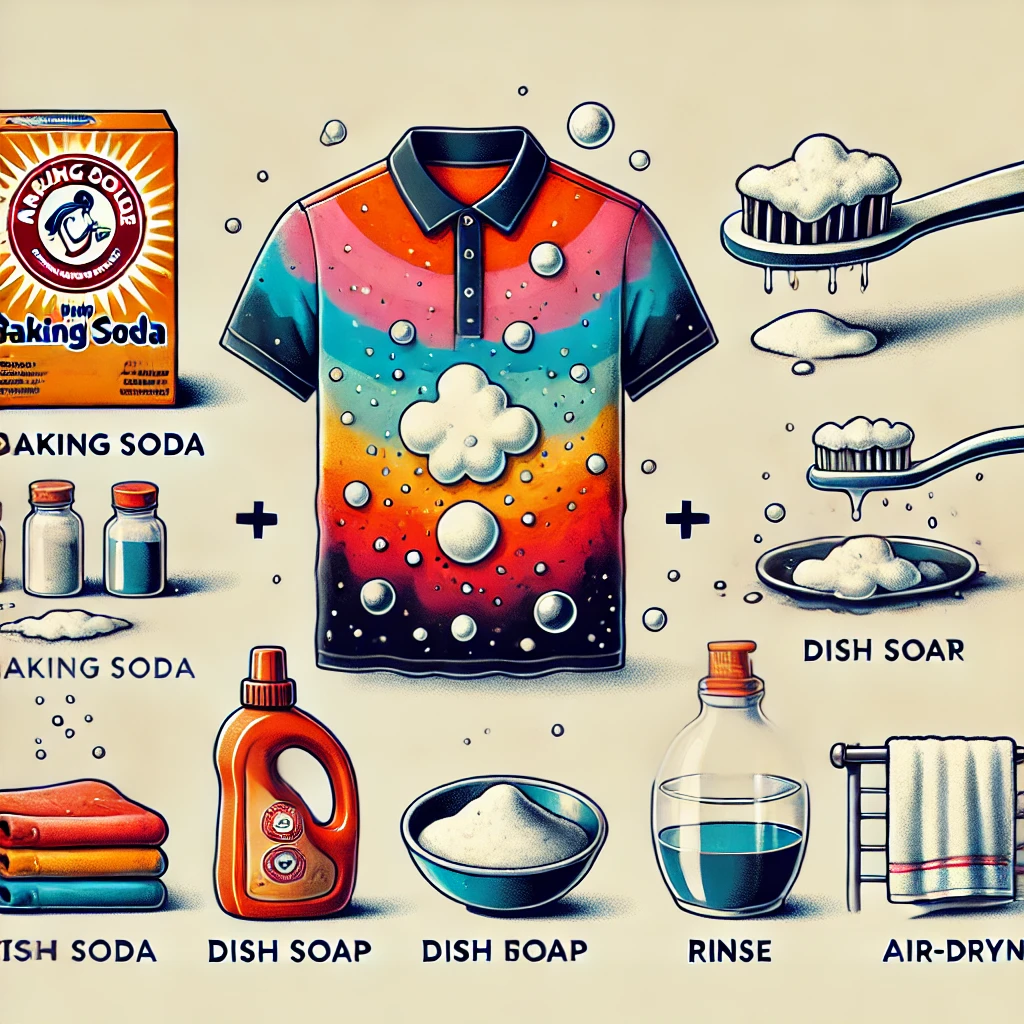
Oil stains on clothing are a common nuisance, often appearing when we least expect them whether it’s from cooking, eating, or handling greasy items. These stains are particularly tricky on colored fabrics because they not only risk setting into the material but also pose a threat to the garment’s vibrant hues if treated improperly. Addressing oil stains promptly is essential because oil has a tendency to seep into the fibers, making it harder to remove over time.
The main challenge lies in finding the balance between removing the stain and preserving the fabric’s color. Harsh chemicals or aggressive scrubbing can lead to fading or damage, so a careful approach is key. The good news is that with the right materials and techniques, it’s entirely possible to tackle oil stains effectively without compromising the beauty of your clothes.
To ensure success, this article will walk you through a detailed process of oil stain removal, highlighting common household items and specialized tools that will help you achieve clean, stain-free colored clothing.
Materials You’ll Need
Before diving into the stain removal process, it’s important to gather the right materials. You likely already have several of these items in your home, while others might require a quick trip to the store.
- Common Household Items:
- Dish Soap: A powerful grease-fighting agent that breaks down oil effectively.
- Baking Soda or Cornstarch: Absorbent powders that lift oil from fabric fibers.
- White Vinegar: A natural solution that works well for gentle stain removal.
- Specialized Products:
- Stain Removers: Products designed specifically for treating oil stains without harming colored fabrics.
- Enzymatic Cleaners: Effective for breaking down tough, set-in oil stains.
- Tools:
- Soft-Bristle Brush: Ideal for gently scrubbing the stain without damaging the fabric.
- Microfiber Cloth: Useful for blotting excess oil and cleaning the fabric.
- Basin or Sink: For soaking and rinsing the garment during treatment.
With these materials in hand, you’ll be well-prepared to tackle even the toughest oil stains on your colored clothes. Following the correct steps and using the appropriate tools will not only save your garments but also help maintain their vibrant, colorful appearance.
Preparation Before Treating the Stain
Proper preparation is crucial when dealing with oil stains on colored clothes. Rushing into stain removal without careful consideration can lead to permanent damage or fading. By following these preparatory steps, you can ensure the stain is treated effectively while protecting the fabric’s color and texture.
Checking the Care Label of the Garment
Before attempting any stain removal, always check the garment’s care label. This small tag contains vital information about the fabric’s composition and how it should be handled. Pay attention to instructions regarding water temperature, recommended detergents, and whether the garment can be machine-washed or requires dry cleaning. For delicate or dry-clean-only fabrics, avoid DIY treatments and consult a professional cleaner instead. Ignoring the care label may result in irreversible damage, such as shrinking, fading, or distortion of the fabric.
Blotting Excess Oil Without Spreading It
The first step in treating an oil stain is to remove as much of the excess oil as possible. Use a clean, dry paper towel or a microfiber cloth to gently blot the stain. Be careful not to rub or press too hard, as this can push the oil deeper into the fibers or spread it to other areas of the fabric. Work from the outer edges of the stain toward the center to contain the affected area. The sooner you blot the stain, the easier it will be to remove, as fresh stains are less likely to have penetrated deeply into the fabric.
Avoiding Hot Water Initially to Prevent Setting the Stain
While hot water may seem like an effective way to remove stains, it can actually set oil stains permanently into the fabric, especially on colored clothes. Heat causes oil molecules to bond more firmly with the fibers, making the stain much harder to remove. Instead, use cold or lukewarm water during the initial stages of treatment. This helps loosen the oil without locking it in place, giving you a better chance of completely removing the stain during the cleaning process.
Step-by-Step Process to Remove Oil Stains
Removing oil stains from colored clothes requires a methodical approach to ensure the stain is eliminated without harming the fabric’s color or texture. Follow these steps carefully to achieve the best results:
Step 1: Sprinkle Baking Soda or Cornstarch on the Stain
Start by applying a generous amount of baking soda or cornstarch directly to the stained area. These powders are highly absorbent and work by drawing out the oil trapped in the fabric fibers. Let the powder sit on the stain for at least 15–30 minutes, or longer for heavier stains. For deep stains, lightly press the powder into the fabric to ensure it penetrates. This step reduces the amount of oil in the fabric, making subsequent cleaning easier.
Step 2: Gently Brush Off the Powder and Apply Dish Soap or Stain Remover
Once the powder has absorbed the oil, gently brush it off with a soft-bristle brush or shake it out over a sink. Next, apply a small amount of grease-fighting dish soap or a stain remover directly to the stained area. Dish soap is particularly effective because it’s designed to break down grease and oil. Work the soap into the stain using your fingers or a cloth, ensuring it coats the entire area.
Step 3: Gently Scrub the Stain with a Soft-Bristle Brush
Using a soft-bristle brush, gently scrub the soapy area in circular motions. This helps lift the oil particles from the fibers. Be cautious not to scrub too hard, as this may damage delicate fabrics or fade the color. For stubborn stains, allow the dish soap to sit for a few minutes before scrubbing to give it more time to work.
Step 4: Rinse with Cold Water and Inspect the Stain
Rinse the treated area thoroughly with cold water to remove the soap and loosened oil. Hold the fabric under running water and gently rub the area with your fingers to ensure all soap and residue are washed away. After rinsing, inspect the stained area in natural light. If the stain persists, move to the next step.
Step 5: Repeat the Process If Necessary
If the stain is still visible, repeat Steps 1–4 until it is fully removed. Some oil stains may require multiple treatments, especially if they have had time to set into the fabric. Each repetition should show noticeable improvement.
Special Tips for Colored Clothes
Removing oil stains from colored clothes requires extra caution to protect the vibrancy of the fabric. These special tips will help you treat stains effectively while preserving the colors:
- Use Color-Safe Detergents and Stain Removers: Choose products specifically labeled as safe for colored fabrics. These are formulated to clean without causing fading or discoloration.
- Test Treatments on an Inconspicuous Area: Before applying any cleaning agent, test it on a hidden section of the garment to ensure it doesn’t alter the fabric’s color or texture.
- Avoid Harsh Chemicals Like Bleach: Bleach and other strong chemicals can cause fading and weaken the fibers, making them unsuitable for treating oil stains on colored clothes. Opt for milder solutions instead.
Alternative Methods for Stubborn Stains
For particularly tough or set-in stains, alternative methods can be just as effective as traditional approaches:
- Using Vinegar and Baking Soda for Natural Stain Removal: Combine white vinegar with baking soda to create a paste. Apply it to the stain, let it sit for 15–20 minutes, and rinse with cold water. This method is gentle and safe for most fabrics.
- Treating with Enzymatic Cleaners for Protein-Based Oils: If the oil stain comes from sources like food or body oils, enzymatic cleaners are excellent for breaking down the stain. Apply according to the product instructions.
- Trying Commercial Oil Stain Removers Designed for Fabrics: Specialized products are often formulated to target oil stains specifically. Always follow the manufacturer’s instructions and verify that the product is safe for colored fabrics.
Washing and Drying After Stain Removal
After the stain has been treated, proper washing and drying techniques are essential to complete the process:
- Wash the Garment as Per Care Instructions: Use the washing method and water temperature recommended on the care label. Stick to cold or lukewarm water unless the label specifies otherwise.
- Inspect the Stain Before Drying: Ensure the stain is completely gone before placing the garment in the dryer. Heat from the dryer can set any remaining stain permanently.
- Air Dry to Ensure Full Removal: If you’re unsure whether the stain is gone, air dry the garment first. This allows you to inspect the area again without the risk of setting any residual stain with heat.
Preventive Measures to Avoid Oil Stains
While it’s helpful to know how to remove oil stains, prevention is always better than cure. Here are some tips to minimize the risk of staining:
- Wear an Apron While Cooking: Aprons provide a protective barrier against splashes and spills, especially when handling oils.
- Use Napkins or Paper Towels to Shield Clothes: When eating or handling greasy foods, place a napkin or paper towel over your lap or chest to prevent accidental stains.
- Pre-Treat Potential Stain-Prone Areas on Garments: For clothes you frequently wear in environments prone to stains, consider applying a fabric protector spray or pre-treating with a stain-resistant solution.
Read more: How to remove oil stains from clothes
Conclusion
Oil stains on colored clothes can be stubborn, but with the right approach, they are far from permanent. Acting promptly, using the correct materials, and following a step-by-step process ensures you can remove stains without compromising the vibrancy of your garments. Preparation is key—always check the care label and handle the stain carefully to avoid spreading it. From household remedies like baking soda and vinegar to specialized stain removers, there are numerous methods to tackle even the toughest stains.
Equally important is knowing how to wash and dry the garment post-treatment to prevent setting any residual stain. And remember, prevention is always better than cure—simple habits like wearing an apron or using napkins can go a long way in protecting your clothes from oil stains.
By incorporating these strategies into your routine, you can confidently handle oil stains while keeping your wardrobe looking fresh and colorful. With a little care and patience, even the most daunting stains can be a thing of the past.
